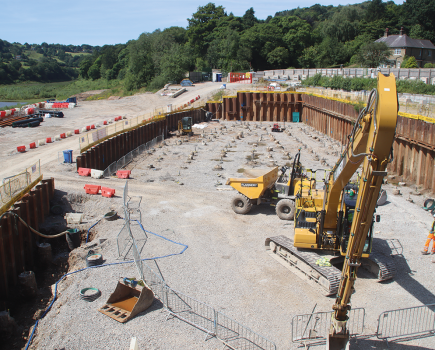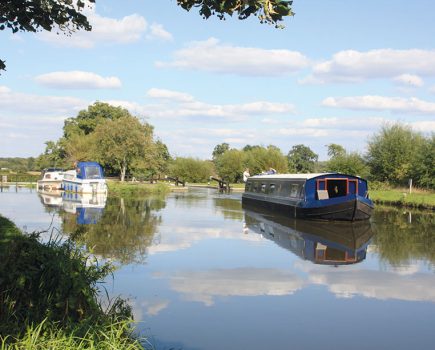It’s taken 23 years for this particular dream to become reality and the result is a stunning and most unusual boat

Words: Adam Porter; Pictures: Andy R Annable
The old saying ‘good things come to those who wait’ extols the virtue of patience – and here’s a boat that proves it’s true. This boat is definitely a good thing – it was probably the most eye-catching of those at the Crick Boat Show this year, and came second in the vote for Favourite Boat.
But its owner, Phil Butler, hasn’t exactly rushed into anything. “I went on a canal holiday with some friends in 1993, and said then that I’d have my own boat,” he says. But it wasn’t until 2010 when he started looking into having one built, and it was only this year that his project was finally finished.
One reason it’s taken a long time from dream to reality is that it’s a very unusual boat. On the outside, it’s styled like an old working boat, but on the inside, there’s reclaimed timber, a vintage engine and a sprinkling of technology. If any Crick boat is worth a closer look, it’s this one.

Exterior
The first thing you notice is that Betty looks a lot longer than it actually is. Maybe this is because the eye is tricked by the front half of the boat, which is the shape of a clothed working boat, or perhaps it’s because you expect a working boat to be in the 70ft-plus range. Whatever the reason, it comes as a surprise to find it’s only 57ft long.
The shell is by Mel Davis, known for his handsome and elegant steelwork. Phil chose him for a number of reasons. Firstly, he liked the quality of Mel’s workmanship on previous boats, particularly the welds, and secondly, Mel was on board for the challenge of building a boat inspired by a working boat.
“When I told him what I wanted, he just stopped,” says Phil. “I thought he was going to throw me out of his yard – but then said he’d always wanted to build a boat like that.”

The shell provides plenty to admire. The bow is exceptionally pretty, and the top bends have a seamless curve into the stem post. The whole bow is long, mainly because Phil wanted enough room in the nose for a washing machine. Yet despite aesthetics not being top of the agenda, they’ve won anyway. The gunwales are slightly higher than usual, to emphasise the working boat look, and rather than the more normal rolled edges, these gunwales come to a sharp angle.
There’s relatively little decoration. The handrails, for example, don’t have scrolls, just nicely angled ends. The recessed panels at the stern have a pleasing planking effect. On the roof, there are a couple of pigeon boxes, and the riveted panel over the engine room is real (the engine really did go in through that hole).
Mel Davis had already begun building solid sides to the clothed section of the boat when Phil decided huge windows would be better. This decision is surely one of the great successes of this boat, but he says it presented some challenges.
The shell needed to be rigid, but without all the usual bracing. That problem was solved by using 40mm box sections as the main framework, with angle irons to hold the windows. And to make sure the windows didn’t crack, everything had to be very precise. The top plank is made from folded steel and at 18 inches, it’s wider than a real plank would have been.

The windows themselves are high spec – argon-filled sealed doubled glazed units, using laminated glass on the outside and toughened glass inside.
The boat is painted with a classic green colour scheme, but with orange used as an accent colour, used just enough to brighten things up without becoming over-powering. It’s a combination that works well. It was painted by Steve Furniss, whose Grand Union Narrowboat Services is based at the same yard in Northamptonshire as Jim Birch, who fitted-out the boat. The sign-writing is by Colin Dundas, based just a couple of miles along the Grand Union.
The words on the boat all have meaning. Betty was Phil’s mother, while Butler Bros really did exist. They were Phil’s grandfather and his brothers, coal merchants in Hawkhurst in Kent.
Fit-out and layout

Jim Birch has built a reputation for fitting-out boats with reclaimed timber and this boat is no exception, with wood from both a pub and a church.
The character exuding from this old timber is exceptional. The other thing you notice is the range of different woods and colours on show as the fashion for uniformity is firmly rejected, showing you can achieve harmony without having everything the same.
Reclaimed timber often arrives in a bit of a state and takes a significant amount of time to restore. It’s pressure washed before being lightly sanded and then either waxed or varnished, depending on where it will be used.
The boat itself has a standard layout, with the saloon at the bow under the glass. The galley is open plan to the saloon and a corridor takes you past a shower and a separate loo. Next comes the engine room, followed by a back cabin.

Well deck
Normally, the well deck would be included as part of the exterior, but it’s really an extension of the interior in this boat. That’s partly because the cover over the deck is a continuation of the cloths covering the ‘hold’ windows, and partly because this really is like another room.
There are substantial lockers each side of the deck, made from the wooden floor of a pub in Rugby. You get the impression the wood could tell more than a few tales. The water tank is under this part of the deck, which explains why there’s a step up. Between the lockers, a door provides access to what would normally be the gas locker. This is a gas-free boat though, and the locker is where the washing machine is hidden.
There’s a choice of tables to go between the lockers, making this a great al fresco eating area, and the whole thing converts into a guest bed, providing the boat’s extra berths.

Saloon
More of the Rugby pub wood is used for the floor of the saloon and galley. It’s set in a keelson fashion, with the keelson plank itself from a different source, the former Hyatt hotel in Birmingham. The boards are fixed to ply, to make sure they don’t move.
There’s more reclaimed timber on the hull sides, beautiful panels from church pews and the skirting board is the hymnbook shelf. Jim held on to this wood for some time, waiting for the right project to make use of it. “This boat just called out for it,” he says.
Above the pew panels and below the windows there is a run of cubby holes and drawers in the style of a toolmaker’s chest along both sides of the boat. It’s a great way of filling the gap left because the panels weren’t quite tall enough – so one of the saloon’s most endearing features happened almost by accident.

The other great woodworking feat here is the curved beams between the windows. Each one was steam bent and shaped using a form. Jim went to Ely Cathedral to look at how the joints in such beams should be made. Each one is like a mini sculpture.
At first sight, the small amount of ceiling in the saloon, on the underside of the top plank, looks fairly straightforward. But it hides a secret. There are ducts inside connected to individually switched fans, some designed to bring fresh air in, while others take cabin air out. In this way, it’s possible to regulate the temperature.
Galley
Usually, when a galley has a range, it’s the star of the show. But the blue Heritage Compact Duette in this galley (which provides heating and hot water as well as cooking facilities) has serious competition from the beautiful worktops. They’re made from chunky reclaimed pieces of black American walnut and you can’t help but touch them.

The cupboard doors are made from reclaimed wood, pine in this case. One of them hides a 240-volt fridge. The very traditional look of this galley is complemented by a Belfast sink.
A set of side doors offers an extra way in and out of the boat, and the steps slice though the units in an organic way. Each step has a drawer, for extra storage.
Shower room
There isn’t a shower room as such. Instead, there’s a corridor with a door to a shower cubicle and another to a separate loo. Phil was keen that he’d be able to walk through the boat, even if someone else was using either facility. Along the corridor, all the light switches are made from Bakelite.

The shower is set up like a wet room. A made-to-measure polypropylene tray takes up the entire floor and it’s covered in Altro marine flooring. There’s a basin in the corner, cubby holes built into the walls and a copper pipe radiator. A pigeon box in the roof lets out the steam. The tiles are bevelled and set in a brick pattern, to continue the traditional look.
The toilet compartment is next door, and currently contains a Porta-Potti. There’s a black water holding tank under the floor, so a pump-out loo could be fitted, but Phil hasn’t decided exactly what he wants yet. He’s considering a composting toilet. This small space uses a combination of reclaimed wooden panels and painted tongue and groove. Phil’s love of railways comes through, with a notice about not using the toilet while in the station.
Engine room
Wood gives way to paint on the walls in the engine room, a mix of grey panels and white tongue and groove. Plus, there are plenty of cupboards made from reclaimed oak hiding the modern electrics.

The centrepiece of the room is the magnificent Gardner engine, more later. There are yards of copper pipes to polish, as well as pierced brass on the exhaust. The use of brass vents and bulkhead lights, and another copper pipe radiator, looks just right.
Back cabin
The layout of the back cabin is traditional, with a bench seat down one side and a big unit opposite, containing all the usual cupboards. They include a pull-down flap to create a cross bed and a table and knife drawer. There are also some high level units over the bench seat, including an eyebrow cupboard over a porthole.
What’s not so traditional is the oak is unpainted, with no scumbling or decoration. Jim says in the days when working boats were built, they used scumbling to make cheap materials look better. Today, we can afford to use real oak in a cabin like this and it looks great – it would have been a shame to cover it up.

A reclaimed and reconditioned Premier stove sits in the corner and ladder-style steps lead up to the rear deck. These are removable and a door behind gives access to the weed hatch.
Technical
One of the joys of a vintage engine is finding out when it was built, and how it’s spent most of its life. The Gardner in this boat was built in 1959 and fitted into a fishing boat in the West Country. It was restored by Joe McCool from Tangent Engineering in County Tyrone.
It’s a 3LW – the three-cylinder version of the Gardner – chosen because Phil intends to spend much of his time on rivers and thought he needed a bit more grunt than the twin-cylinder engine. Indeed, even before being completely finished, this boat has already done the challenging run down the Thames and around the coast to the River Medway and back.

The electrical system is 24 volts, which Phil prefers to 12-volt. There are four 120Ah AGM batteries and a Victron 3kW inverter/charger for a 240-volt supply. Cabling has been installed for a yet-to-be-connected digital music system.
On the water
This boat looks fantastic on the water and sounds just as good. The engine is happy ticking over, but when you wind the speed wheel, it’s clear there’s a lot of power available.
There are traditional controls, with a handle to push or pull for forward and reverse gears, and a wheel to increase or reduce revs. This is clearly a heavy boat with a deep draught, but it handles well.

It turns easily, as you might expect from a Mel Davis shell, with nice long swims. Perhaps more surprising is how light the steering is, there’s no sense of having to struggle with the tiller to turn. In short, we couldn’t fault the handling.
Conclusion
This is an outstanding boat, although you have to acknowledge it wouldn’t be for everyone.
All the glass in the saloon means privacy is (quite literally) out of the window, and some people wouldn’t want the task of rolling up and folding down the covers all the time.
And it has cost a lot of money. Phil reckons he’s spent something over £200,000 on Betty, although he admits if he’d been more efficient in some of his decision-making, it could have been done for less money and in less time.
But the result is a truly individual boat, with top quality workmanship. It has a stunning shell, while the interior is a one off. The reclaimed timber and the craftsmanship has given it a new purpose and the results are superb.
Betty might have taken a long time to get from idea to execution, but good things come to those who wait.
__________________
You may also like:
Boat Test: Wharf House 41ft 6in
Boat Test: Columbus – winner of Crick 2015
Image(s) provided by:
Archant







